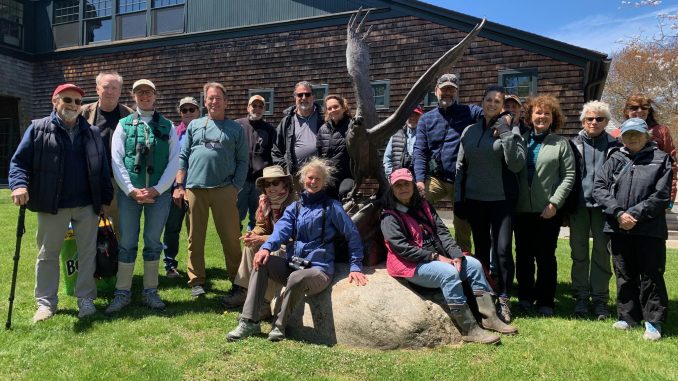
On a sunny Tuesday morning last week, the Sound View Dunes Park in Southold was humming with an orchestra of bird sounds, and Tom Damiani could name just about every instrument and each note that rang out in the wooded beachside preserve.
There was the “hoooo-hoooo” of the mourning dove, the “meow” sound the catbird makes, the prairie warbler’s “zzzzzz,” the trilling of the great crested flycatcher that sounds like a referee’s whistle, and the noisy, raspy chatter of the Carolina wren.
There were enchanting eastern mockingbirds, which can imitate each bird call they hear, because their vocal cords can produce a wide variety of sounds. And there were eastern towhees, large sparrows, which one birder described as looking like they “dipped their head in ink.”
For decades now, Mr. Damiani — outreach coordinator for the North Fork Audubon Society — has been leading birders and the bird-curious on walks through some of the North Fork’s richest habitats. These woodlands include Laurel Lake Preserve, Granttham Preserve, Hallock State Park Preserve, Inlet Pond County Park and Mashomack Preserve on Shelter Island. In addition to “Tuesdays with Tom,” Mr. Damiani hosts bird walks for beginners, though any skill level is welcome on any bird walk. May is peak migration month for countless species and the best time to birdwatch is now.

Yet with Mr. Damiani it’s more than a lesson in birdwatching. Along the way, there are informal insights about pitch pines and the red oaks that warblers feast on and the curious sound of the gray tree frog.
“It’s all interconnected,” Mr. Damiani said. “It’s like a big web. Everything is connected to something, so when you point these things out for people, especially beginners, it gives them more of an understanding of nature, and more connectedness to nature.”
On the walk, North Fork Audubon Society president Peggy Lauber shared an interesting tech innovation for birders: an app called Merlin Bird ID, created by the Cornell Lab of Ornithology — which uses AI to identify the bird by the sound of its song.
Between the app and the many expert ears, Tuesday’s group identified a mallard, two white-winged scoters, four mourning doves, three loons, a double-breasted cormorant, a pair of red-bellied woodpeckers, five great crested flycatchers, a red-eyed vireo, a blue jay, an American crow, a fish crow, a tufted titmouse, a white-breasted nuthatch, two Carolina wren, six American goldfinches, two eastern towhees, a field sparrow, three red-winged blackbirds, five yellowthroat and six yellow warblers, two pine warblers, a prairie warbler and a northern cardinal.
“It’s always interesting,” said Jim Romansky, a former science teacher from South Jamesport. “It’s sort of like prospecting — you don’t know what you’re going to find. And it’s a mystery — you don’t always know what you’re looking at.”
Mr. Damiani said one of the most curious sightings of his in recent memory wasn’t deep in any woods, but on the fairway of the Sandy Pond nine-hole golf course, where he tends to nest boxes for tree swallows and bluebirds.
“There was this greater yellowlegs right in the fairway and a lesser yellowlegs … they’re always hard to tell apart. And I thought ‘look at the size difference. The beak is totally different, the bills are different.’ And that’s exciting in a way, even if you’ve been birding for a long time.”
For all his interest in spotting rare birds, Mr. Damiani is still old-school about his hobby.
“This lazuli [bunting] that landed in Flanders? I didn’t go see it,” he said. “When they get a rare bird alert, the people that run to go see it are called ‘chasers’. I just won’t do that. I want to find that on my own.”

